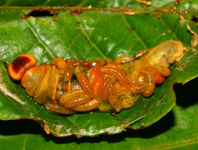Abstract
A new genus of braconine parasitoid wasp, Acgorium Sharkey & Quicke gen. nov., based on a new species from Costa Rica, Acgorium felipechavarriai Sharkey sp. nov., is described and illustrated, based on specimens reared from wild-caught hesperiid caterpillars of Dyscophellus phraxanor (Hewitson). Acgorium felipechavarriai is the first known braconine gregarious ectoparasitoid of a butterfly caterpillar.
References
Janzen, D.H. (2000) Costa Rica’s Area de Conservación Guanacaste: a long march to survival through non-damaging biodevelopment. Biodiversity, 1, 7–20.
https://doi.org/10.1080/14888386.2000.9712501
Janzen, D.H. & Hallwachs, W. (2011) Joining inventory by parataxonomists with DNA barcoding of a large complex tropical conserved wildland in northwestern Costa Rica. PLoS ONE, 6, e18123.
https://doi.org/10.1371/journal.pone.0018123
Janzen, D.H. & Hallwachs, W. (2016) DNA barcoding the Lepidoptera inventory of a large complex tropical conserved wildland, Area de Conservacion Guanacaste, northwestern Costa Rica. Genome, 59, 641–660.
https://doi.org/10.1139/gen-2016-0005.
Janzen, D.H. & Hallwachs, W. (2019a) Dynamic database for an inventory of the macrocaterpillar fauna, and its food plants and parasitoids, of Area de Conservacion Guanacaste (ACG), northwestern Costa Rica. Available from: http://janzen.sas.upenn.edu/caterpillars/database.lasso (accessed 30 June 2020)
Janzen, D.H. & Hallwachs, W. (2019b) How a tropical country can DNA barcode itself. iBOL Barcode Bulletin, 9 (1), 1–6.
https://doi.org/10.21083/ibol.v9i1.5526
Janzen, D.H., Hallwachs, W., Blandin, P., Burns, J.M., Cadiou, J.-M., Chacon, I., Dapkey, T., Deans, A.R., Epstein, M.E., Espinoza, B., Franclemont, J.G., Haber, W.A., Hajibabaei, M., Hall, J.P.W., Hebert, P.D.N., Gauld, I.D., Harvey, D.J., Hausmann, A., Kitching, I.J., Lafontaine, D., Landry, J.-F., Lemaire, C., Miller, J.Y., Miller, J.S., Miller, L., Miller, S.E., Montero, J., Munroe, E., Green, S.R., Ratnasingham, S., Rawlins, J.E., Robbins, R.K., Rodriguez, J.J., Rougerie, R., Sharkey, M.J., Smith, M.A., Solis, M.A., Sullivan, J.B., Thiaucourt, P., Wahl, D.B., Weller, S.J., Whitfield, J.B., Willmott, K.R., Wood, D.M., Woodley, N.E. & Wilson, J.J. (2009) Integration of DNA barcoding into an ongoing inventory of complex tropical biodiversity. Molecular Ecology Resources, 9 (Supplement 1), 11–26.
https://doi.org/10.1111/j.1755-0998.2009.02628.x
Miller, J.C., Janzen, D.J., Hallwachs, W. (2006) 100 Caterpillars: Portraits from the Tropical Forests of Costa Rica. Belknap Press, Cambridge, Massachusetts, 272 pp.
Papp J. (2007) A new genus and two new species of Braconidae (Hymenoptera) dedicated to Lásló Gozmány. Acta Zoologica Academiae Scientiarum Hungaricae, 53, 295–305.
Papp, J. (2012) A taxonomic study of the Myosoma genus-group with description of Amyosoma cavei sp. n. from Honduras (Hymenoptera: Braconidae: Braconidae: Braconini). Acta Zoologica Academiae Scientiarum Hungaricae, 58, 1–29.
Quicke, D.L.J. (1994) Myosomatoides gen. nov., (Hymenoptera: Braconidae), a Neotropical larval parasitoid of stem-borer pests, Diatraea (Lepidoptera: Pyralidae). Journal of Hymenoptera Research, 3, 227–231.
Quicke, D.L.J. (1995) Two new Neotropical genera of Braconinae (Hym., Braconidae). Entomologists’ Monthly Magazine, 131, 223–228.
Quicke, D.L.J. & Delobel, A. (1995) A new neotropical braconine (Hym., Braconidae) parasitic on Bruchidae (Col., Bruchidae). Entomologists’ Monthly Magazine, 131, 215–221.
Quicke, D.L.J. (1997) Subfamily Braconinae. In: Wharton, R.A., Marsh, P.M. & Sharkey, M.J. (Eds.), Identification manual to the New World genera of Braconidae. Special Publication of the International Society of Hymenopterists No. 1. The International Society of Hymenopterists, Washington, D.C., pp. 148–174.
Quicke, D.L.J. (2015) The Braconid and Ichneumonid Parasitic Wasps: Biology, Systematics, Evolution and Ecology. Wiley Blackwell, Oxford, 688 pp.
https://doi.org/10.1002/9781118907085
Quicke, D.L.J. & Sharkey, M.J. (1989) A key to and notes on the genera of Braconinae (Hymenoptera: Braconidae) from America North of Mexico with descriptions of two new genera and three new species. Canadian Entomologist, 121, 337–361.
https://doi.org/10.4039/Ent121337-4
Sharkey, M.J. & Wharton, R.A. (1997) Morphology and terminology. In: Wharton, R.A., Marsh, P.M. & Sharkey, M.J. (Eds.), Identification manual to the New World genera of Braconidae. Special Publication of the International Society of Hymenopterists No. 1. The International Society of Hymenopterists, Washington, D.C., pp.19–37.
Shenefelt, R.D. (1978) Braconidae 10. Braconinae, Gnathobraconinae, Mesestoinae, Pseudodicrogeniinae, Telengainae, Ypsistocerinae, plus Braconidae in general, major groups, unplaced genera and species. Hymenopterorum Catalogus (nova editio), 15,1425–1872.
Thompson, W.R. (1953) A Catalogue of the Parasites and Predators of Insect Pests. Section 2 Host Parasite Catalogue. Part 2. Hosts of the Hymenoptera (Agaonidae to Braconidae). Commonwealth Institute of Biological Control, Ottawa, 35 pp.
van Achterberg, C. 1984. Revision of the genera of Braconini with first and second metasomal tergites immovably joined (Hymenoptera, Braconidae, Braconinae).Tijdschrift voor Entomologie, 127, 137–164.
Wharton, R.A., Marsh, P.M. & Sharkey, M.J. (1997) Identification manual to the New World genera of Braconidae. Special publication of the International Society of Hymenopterists No. 1. The International Society of Hymenopterists, Washington, D.C., 439 pp.


